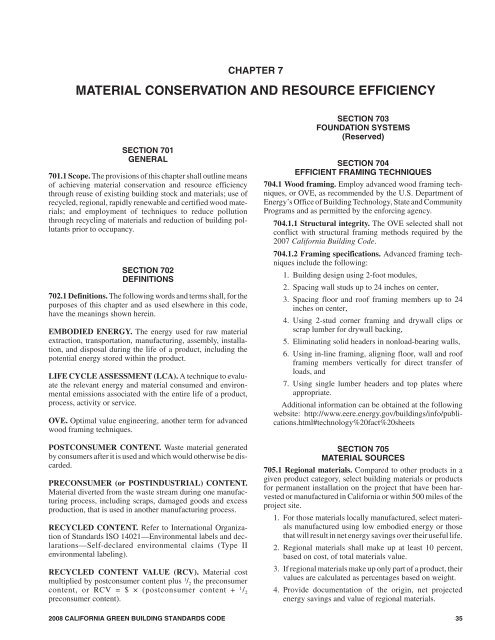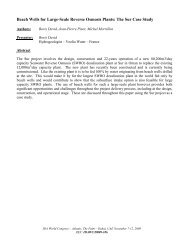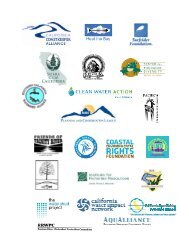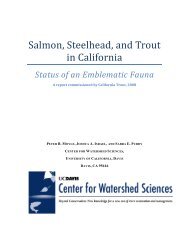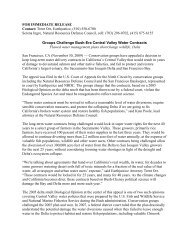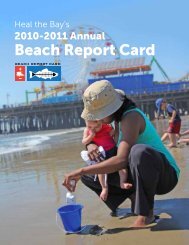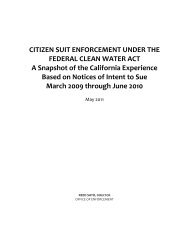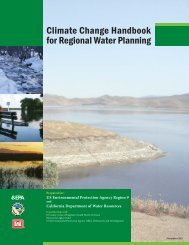Green Building Standards Code - State of California
Green Building Standards Code - State of California
Green Building Standards Code - State of California
You also want an ePaper? Increase the reach of your titles
YUMPU automatically turns print PDFs into web optimized ePapers that Google loves.
CHAPTER 7<br />
MATERIAL CONSERVATION AND RESOURCE EFFICIENCY<br />
SECTION 703<br />
FOUNDATION SYSTEMS<br />
(Reserved)<br />
SECTION 701<br />
GENERAL<br />
701.1 Scope. The provisions <strong>of</strong> this chapter shall outline means<br />
<strong>of</strong> achieving material conservation and resource efficiency<br />
through reuse <strong>of</strong> existing building stock and materials; use <strong>of</strong><br />
recycled, regional, rapidly renewable and certified wood materials;<br />
and employment <strong>of</strong> techniques to reduce pollution<br />
through recycling <strong>of</strong> materials and reduction <strong>of</strong> building pollutants<br />
prior to occupancy.<br />
SECTION 702<br />
DEFINITIONS<br />
702.1 Definitions. The following words and terms shall, for the<br />
purposes <strong>of</strong> this chapter and as used elsewhere in this code,<br />
have the meanings shown herein.<br />
EMBODIED ENERGY. The energy used for raw material<br />
extraction, transportation, manufacturing, assembly, installation,<br />
and disposal during the life <strong>of</strong> a product, including the<br />
potential energy stored within the product.<br />
LIFE CYCLE ASSESSMENT (LCA). A technique to evaluate<br />
the relevant energy and material consumed and environmental<br />
emissions associated with the entire life <strong>of</strong> a product,<br />
process, activity or service.<br />
OVE. Optimal value engineering, another term for advanced<br />
wood framing techniques.<br />
POSTCONSUMER CONTENT. Waste material generated<br />
by consumers after it is used and which would otherwise be discarded.<br />
PRECONSUMER (or POSTINDUSTRIAL) CONTENT.<br />
Material diverted from the waste stream during one manufacturing<br />
process, including scraps, damaged goods and excess<br />
production, that is used in another manufacturing process.<br />
RECYCLED CONTENT. Refer to International Organization<br />
<strong>of</strong> <strong>Standards</strong> ISO 14021—Environmental labels and declarations—Self-declared<br />
environmental claims (Type II<br />
environmental labeling).<br />
RECYCLED CONTENT VALUE (RCV). Material cost<br />
multiplied by postconsumer content plus 1 / 2 the preconsumer<br />
content, or RCV = $ × (postconsumer content + 1 / 2<br />
preconsumer content).<br />
SECTION 704<br />
EFFICIENT FRAMING TECHNIQUES<br />
704.1 Wood framing. Employ advanced wood framing techniques,<br />
or OVE, as recommended by the U.S. Department <strong>of</strong><br />
Energy’s Office <strong>of</strong> <strong>Building</strong> Technology, <strong>State</strong> and Community<br />
Programs and as permitted by the enforcing agency.<br />
704.1.1 Structural integrity. The OVE selected shall not<br />
conflict with structural framing methods required by the<br />
2007 <strong>California</strong> <strong>Building</strong> <strong>Code</strong>.<br />
704.1.2 Framing specifications. Advanced framing techniques<br />
include the following:<br />
1. <strong>Building</strong> design using 2-foot modules,<br />
2. Spacing wall studs up to 24 inches on center,<br />
3. Spacing floor and ro<strong>of</strong> framing members up to 24<br />
inches on center,<br />
4. Using 2-stud corner framing and drywall clips or<br />
scrap lumber for drywall backing,<br />
5. Eliminating solid headers in nonload-bearing walls,<br />
6. Using in-line framing, aligning floor, wall and ro<strong>of</strong><br />
framing members vertically for direct transfer <strong>of</strong><br />
loads, and<br />
7. Using single lumber headers and top plates where<br />
appropriate.<br />
Additional information can be obtained at the following<br />
website: http://www.eere.energy.gov/buildings/info/publications.html#technology%20fact%20sheets<br />
SECTION 705<br />
MATERIAL SOURCES<br />
705.1 Regional materials. Compared to other products in a<br />
given product category, select building materials or products<br />
for permanent installation on the project that have been harvested<br />
or manufactured in <strong>California</strong> or within 500 miles <strong>of</strong> the<br />
project site.<br />
1. For those materials locally manufactured, select materials<br />
manufactured using low embodied energy or those<br />
that will result in net energy savings over their useful life.<br />
2. Regional materials shall make up at least 10 percent,<br />
based on cost, <strong>of</strong> total materials value.<br />
3. If regional materials make up only part <strong>of</strong> a product, their<br />
values are calculated as percentages based on weight.<br />
4. Provide documentation <strong>of</strong> the origin, net projected<br />
energy savings and value <strong>of</strong> regional materials.<br />
2008 CALIFORNIA GREEN BUILDING STANDARDS CODE 35


